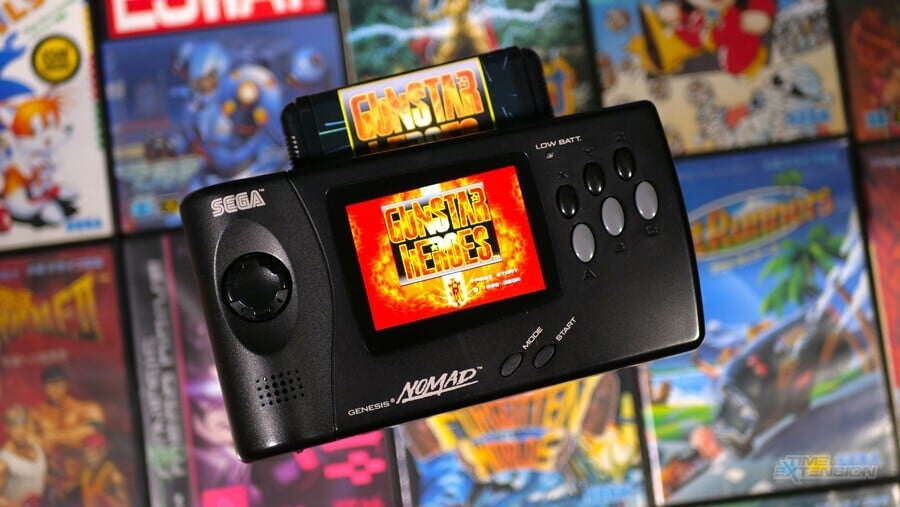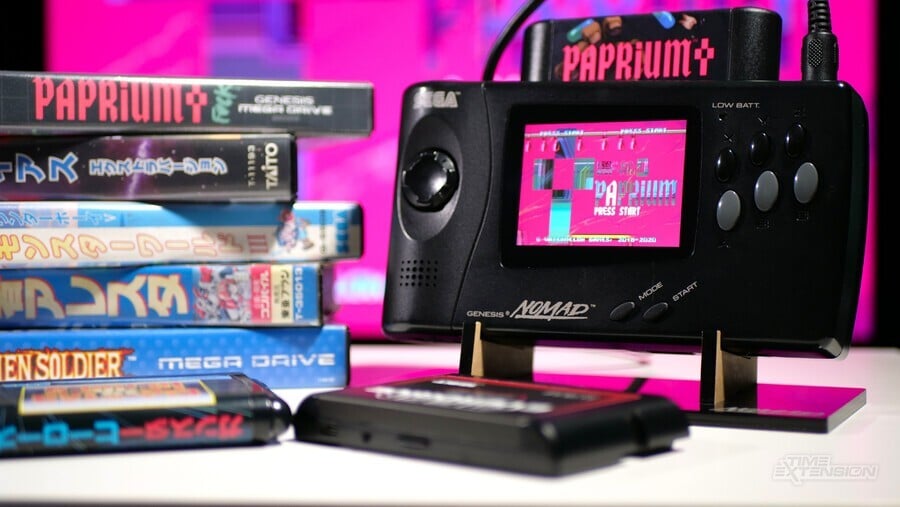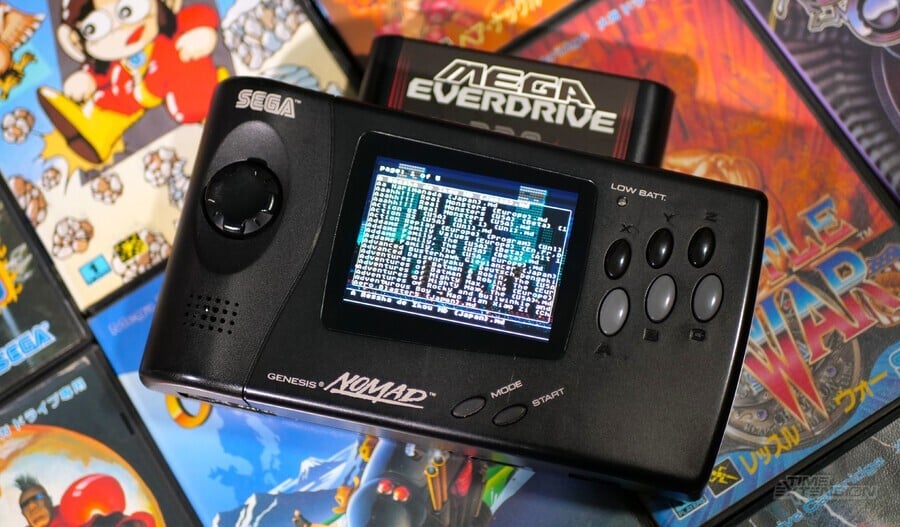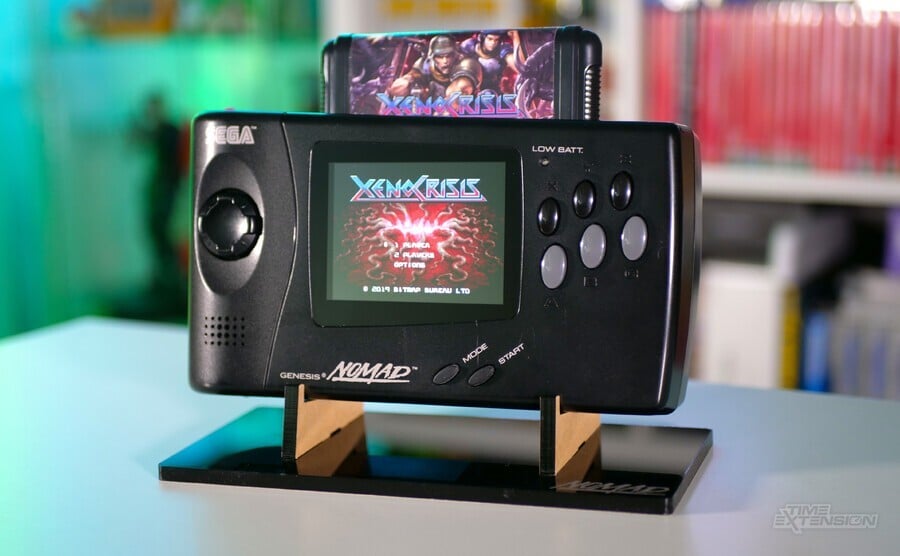
When Nintendo revealed the Switch back in 2016, the whole world seemed pretty impressed—a hybrid console which could be played both on the road and on your TV felt fresh and exciting, and blurred the lines between the traditionally distinct domestic and portable hardware markets.
Of course, there were a select few people who rose slowly from their seats following Nintendo's announcement and raised a finger to exclaim, "Wait a second! I've seen this kind of magic before, and it wasn't on a Nintendo console!" (These are the exact same people you never invite to parties, coincidentally).
They were referring, of course, to Sega's Nomad handheld. Released exclusively in North America in October 1995 for $180, the Nomad was a portable Genesis / Mega Drive capable of playing all of your Genesis / Mega Drive cartridges.
Although the next generation had technically kicked off by this point—both the PS1 and Saturn had launched at the close of 1994 in Japan and were due out in the West that same year—the Genesis still felt like a 'current' platform, so the idea of being able to play relatively recent home console games on the move was a real boon. NEC had performed the same trick with the TurboExpress / PC Engine GT a few years beforehand, of course, but that particular system lacked the Nomad's killer feature: TV play.

Via an AV port on the top of the system, it was possible to plug your Nomad into your TV and have it act like a standard Genesis system—Sega even included a second controller port on the bottom so a friend could join in. This functionality was seen as a neat bonus at the time, but it didn't attract the same fanfare as Switch, for multiple reasons.
The first was that the Genesis was seen as an outgoing platform, so the level of anticipation surrounding the Nomad was noticeably muted. A more pressing concern was the fact that, like the Game Gear, Atari Lynx and TurboExpress, the Nomad positively gulped down AA batteries, with a fresh set lasting around four hours. It was such a bulky unit that Sega wasn't even able to factor batteries into the case design; instead, you had to put six of them inside a special caddy which would bolt onto the back, making an already massive handheld even bigger. The LCD screen, while illuminated, was prone to motion blur, too.
So, as utterly radical as it was to play your entire 16-bit Sega library on the move, the Nomad was not a commercial success and sold poorly; as a consequence, units are relatively rare and now change hands for large sums of cash.
The aforementioned shortcomings of the system have led to several aftermarket modifications, including screen upgrades and external battery packs, but the shining apex of Nomad mods comes courtesy of Oleg Endo, the Japan-based engineer behind the Venus SUB 2020 kit.
Building The Ultimate Sega Nomad
This mod includes Endo's Venus sub-board with a mounted IPS LCD screen, a 5000 mAh rechargeable lithium battery, dual oscillator board, glass screen cover and several other components, and effectively updates the Nomad for the modern era. The most obvious improvement is the display; even when compared to rival Nomad screen upgrades, Endo's solution is light years ahead as it taps into the RGB signal of the console rather than the composite video signal, as is the case with other screens. Compared to the stock Nomad LCD, the difference is even more striking.
The internal battery is the next surprise. Endo has somehow managed to cram a roomy 5000 mAh power cell into the Nomad itself, which means you don't have to use the external battery caddy (although it's worth noting you can still use the Laser Bear rechargeable battery pack with this mod—it will even charge the internal battery if you have one connected). The standard power socket has been replaced with a modern USB-C variant, which means you can juice it up using your phone charger. You get around eight hours of play per charge, and there's even a charging LED which shows when the battery is being topped up (orange) and when it has reached full capacity (green).
The mod doesn't stop there, however. The power switch is now a slider rather than a switch, and you can soft reset the console during play with a quick flick. Endo's mod also boosts the audio from the console's mono speaker, making it louder and clearer, and the board itself has built-in support for a second speaker, which may well be tapped into in a future stereo sound upgrade.
The volume and brightness dials have been replaced with rocker switches, which feel fantastic. You also get an on-screen indication of when you're adjusting either of these, and each rocker has a secondary function tied to a 'press'; on the volume dial, pressing down on the rocker mutes the audio entirely, whereas doing the same on the brightness dial brings up the mod's secret weapon: an on-screen menu packed with amazing functionality.
From this menu—accessible at any time when the unit is powered on—you can select the console's video mode, which also allows you to play games from any region. The stock Nomad is set to NTSC US, which means region-locked games won't normally run on it. However, you can switch the video or language settings using this menu and run the Mega Drive's entire library. It's also possible to select a screen filter (sharp, medium and soft—I prefer the sharp option myself), force a three-button control setup, enable TV-out (the mod disables it by default as it's a power draw), change your video sync options and even turn off the various "quips" which appear when you boot up the system.

You can even boost the Nomad's clock speed up to a maximum of 10 MHz, although this can be somewhat inconsistent when it comes to yielding visible results in-game. Oh, and it also allows you to play Master System games via a flash cartridge, as well as Sega CD / Mega CD games with audio when using a cart like the Mega SD or Mega Everdrive Pro (to get sound when playing Mega CD games, you normally need to perform a separate internal mod).
Roll all of these upgrades into one package, and you've got the ultimate Sega Nomad, which has the potential to get even better because that USB-C charging port also allows for firmware upgrades.
So, what inspired this amazing mod, and how much work has gone into its creation? Keen to learn more, I spoke to the man behind the magic...
The Man Behind The Mod: Meet Oleg Endo
Time Extension: What inspired you to work on the Venus mod?
Oleg Endo: The story is actually very simple. In 2020 I got myself a used Nomad. The primary purpose was to make my kids not occupy the telly all the time playing Mega Drive games. Secondary purpose was me wanting to play Xeno Crisis in bed.
The seller goofed up the packaging by putting the AC power brick directly onto the screen. It arrived broken and I started looking into how to fix it. At that time all existing screen replacement solutions were sold out or were known to have deficits such as severe shimmering during scrolling and so on. Moreover, the Nomad that I got didn't include a battery case, so I had to use the AC power brick at all times.
Those two things (broken screen, missing battery case) are basically the origin of the mod.
Time Extension: What aspect of the mod has taken the most time to get right?
Oleg Endo: I would say definitely the power supply circuits and the software.
With those older, partially analog, devices like the Mega Drive, power supply circuits can be tricky. We see it these days in the form of various "de-noise" or "de-buzz" mod boards for various consoles, which either fully replace or enhance the performance of the original power supply circuits. And in the case of VENUS SUB 2020, it has to deal with multiple power sources and battery charging. While the final solutions might seem obvious and straightforward, it can take quite some time and experimentation to arrive there.
As for the software, coding on the video scaler chip hasn't been a walk in the park. I had to spend quite some time to build and improve development tools. Just to put things into perspective, the new VENUS SUB 2020 board runs software on two 8-bit CPUs and each of them has about 1 KByte of RAM. While it's a fun puzzle to optimize software for such systems, it's also quite time-consuming.
Time Extension: What element of the mod are you most pleased with?
Oleg Endo: That in the end, after all the struggles, I'm able to provide a coherent solution that I had envisioned in the beginning. When I started out, I looked at what other people have done so far, like replacing the screen and stuffing rechargeable batteries into the Nomad. It looked quite adventurous and some of it even dangerous. All of those were some ad hoc patchwork solutions which I didn't like.
Time Extension: Were there any features you wanted to include but couldn't?
Oleg Endo: Yes, quite a few! I had to cut some corners here and there to keep the development time and final product cost in check. Even though I'm starting to slowly roll out the sales, development is still ongoing. I hope to be able to offer some support and enhancements in the future.
Time Extension: One thing I love about the Venus mod is the ability to update the firmware via USB-C. How do you see the firmware evolving over time?
Oleg Endo: Some hardware functions are present but are currently not utilized due to a lack of software support. In addition, there's also a bit of room for some software gimmicks. I hope to unlock those things step by step with future software updates and, of course, provide improvements and fixes for the existing known issues.
Time Extension: What's the feedback been like from the community?
Oleg Endo: Of course, you can't make everyone 100% happy. Some people will always complain about the weather. But overall, it's been quite positive! I'm really grateful for all those folks who've been sticking around and waiting so patiently!
Time Extension: You're doing all of these mods by yourself. Has it been challenging to keep up with demand?
Oleg Endo: To be honest, I underestimated the amount of work and money that had to go into the project in order to achieve the level I was aiming for. There were several occasions on which I wanted to throw in the towel. Modding one or two consoles for myself is one thing, but repeating that hundreds of times for other people is a whole other thing.
Time Extension: Do you have plans for any other console mods in the future?
Oleg Endo: The modding space got really crowded over the past couple of years and has attracted some really bright engineers. I think by now probably virtually every console has been covered by various mods. It gets increasingly more difficult to come up with something new which is practical and useful. I'm not ruling anything out, but for the time being, the Nomad is my priority. I think it still has some potential.

If you'd like to know more about the Venus SUB 2020 kit, you can visit Endo's website.
Editor's note: This piece has been updated to correct some inaccuracies regarding the kit. We apologise for any confusion caused.
